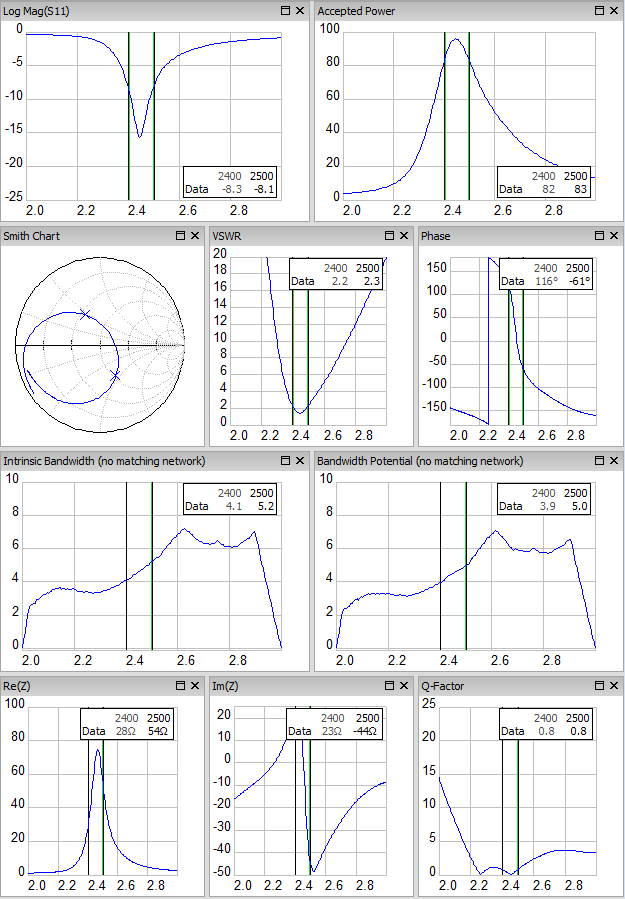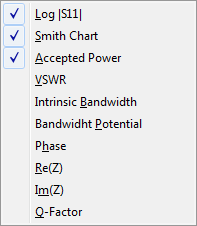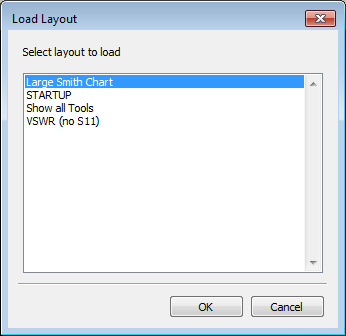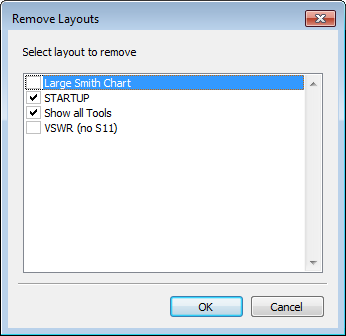LATEST RELEASE: BetaMatch version 3.4.0 - Get it here!

This section will describe the available plots, windows and some general information on how the user interface works.
The following plots are currently available:
The general options and settings described in this section also apply to the plots that are available from the Tools menu: Conversion Plot, Channel Plot and Skin Effect Plot.

All trace plots can be hidden and shown from the View menu. They can also be maximized, restored and closed from the icons on the caption bar:

Other windows can be accessed via the View Menu. The toolbars can also be shown and hidden from this menu. Layouts can be loaded and saved as well:
When the cursor is moved over any of the plot window a square marker is showing the nearest point on the nearest curve. Data for this point is displayed at the top right corner of each plot.
If possible the corresponding data point is shown in the other plots as well.
This linking of cursor data can be turned on and off in the context menu in any of the plots.
All plots can be zoomed and dragged. When zoom-mode is ON the cursor is changed from a cross to a magnifier glass. When drag is enabled the cursor is changed to a hand-cursor.
The plots can be zoomed in two ways:
Dragging can be done by:
Zoom and Drag are intended to be used to read values with enhanced accuracy therefore they are non-persistent. This means that the original plot settings will be restored when the plots are redrawn (e.g. by double-clicking or by changing the matching network).
The user interface is very flexible and you can move, dock/undock, resize and open/close most of the panels.
It is possible to save the current view and load it later or have it automatically loaded when BetaMatch is started. This is done from the View Menu.
These options are in the third section of this menu:
Load Layout: Use this option to select and load a previously saved layout. In the list below there are 4 saved images: One with a large Smith Chart, another where VSWR is shown instead of |S11| and a third where all the conversion plots from the Tools menu are shown. The layout called ‘STARTUP’ will be automatically loaded whenever BetaMatch is started (in this case it is the same as the view called ‘VSWR’).

Save Current Layout: This option lets you save the current layout. Enter a descriptive name in the text box and press OK to save the layout. If you want BetaMatch to automatically load the current layout when it is started save it under the name ‘STARTUP’ (must be capital letters).

Remove Layouts: Layouts can be deleted by ticking the appropriate boxes and pressing OK. Press Cancel to close the window without removing any layouts. If you remove the ‘STARTUP’ layout BetaMatch will use the factory default layout when it is started.

Show All Views: All available windows will be displayed. This will be rather messy, but can be useful when designing a new layout: First display all windows and then close the ones that are not needed.
Restore Defaultview: A shortcut that will load the ‘STARTUP’ view if it exists otherwise the factory default layout will be shown.
Note
It is currently not possible to guarantee compatibility of the saved layouts between different versions of BetaMatch. That means that it may not be possible to correctly load old layouts after BetaMatch has been updated to a later version.
If this happens it is recommended to delete the old layouts via the View ‣ Remove Layouts in the menu and then create and save the layouts again in the new version of BetaMatch.